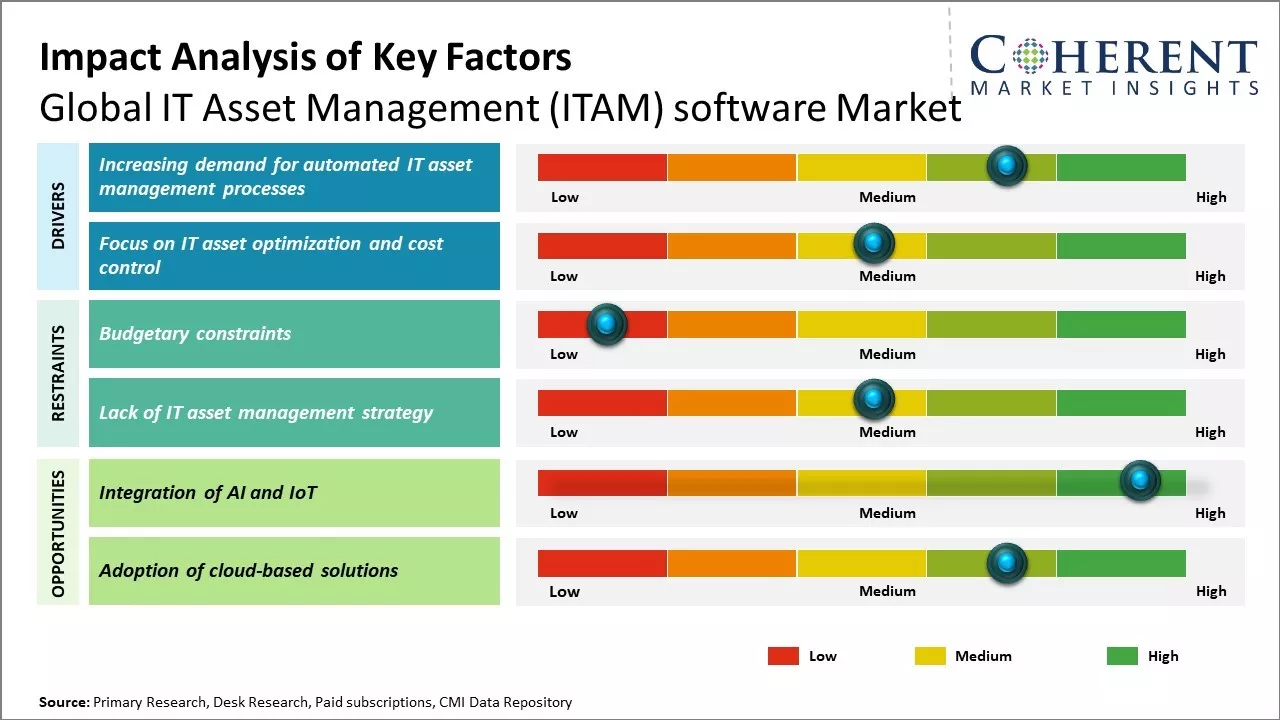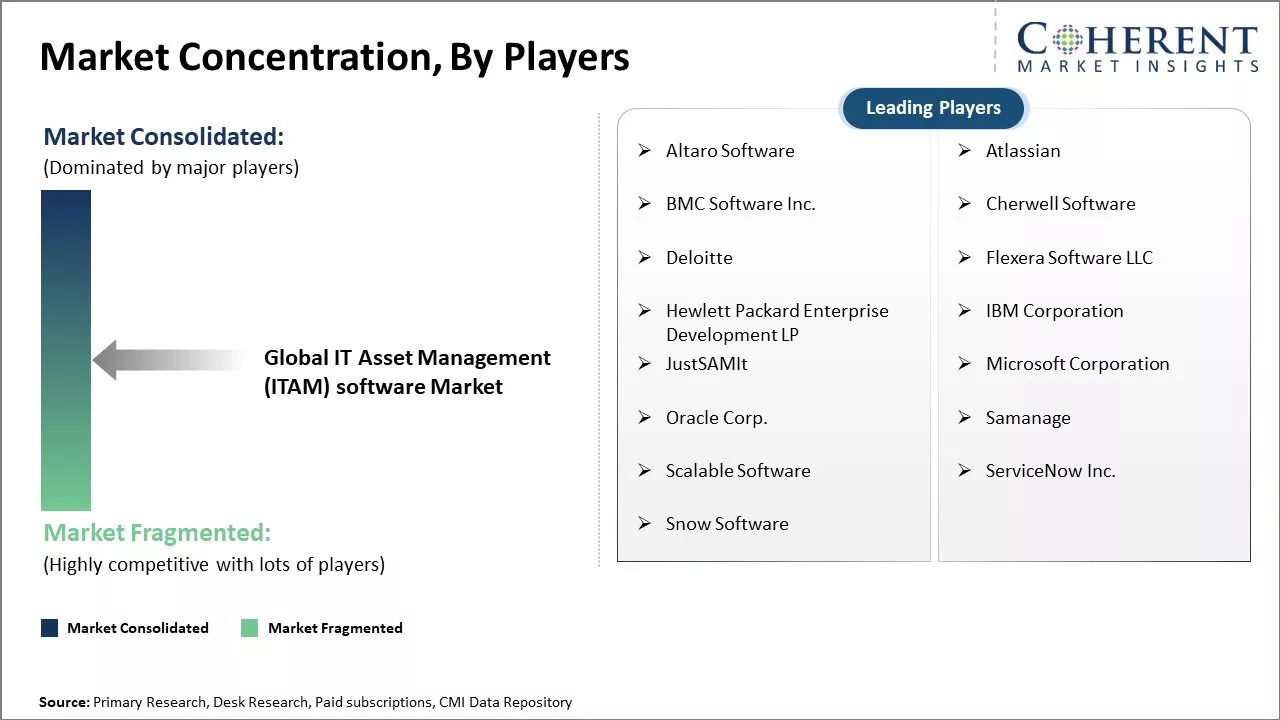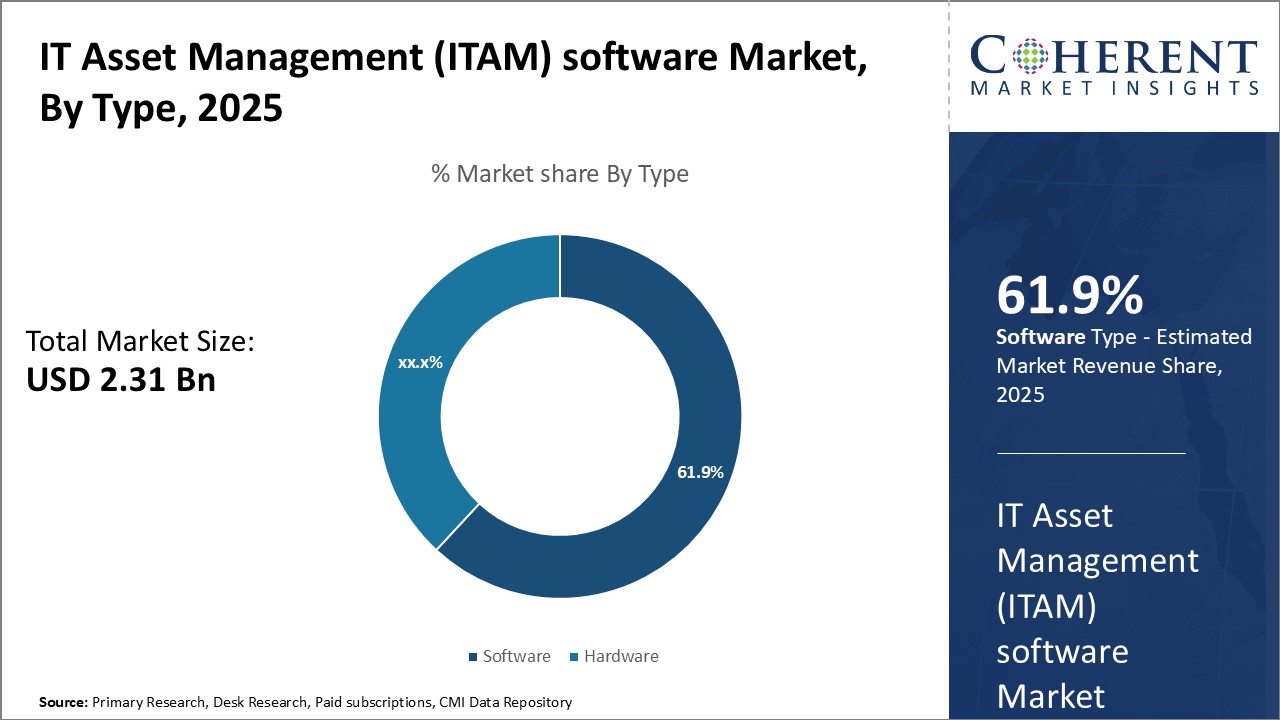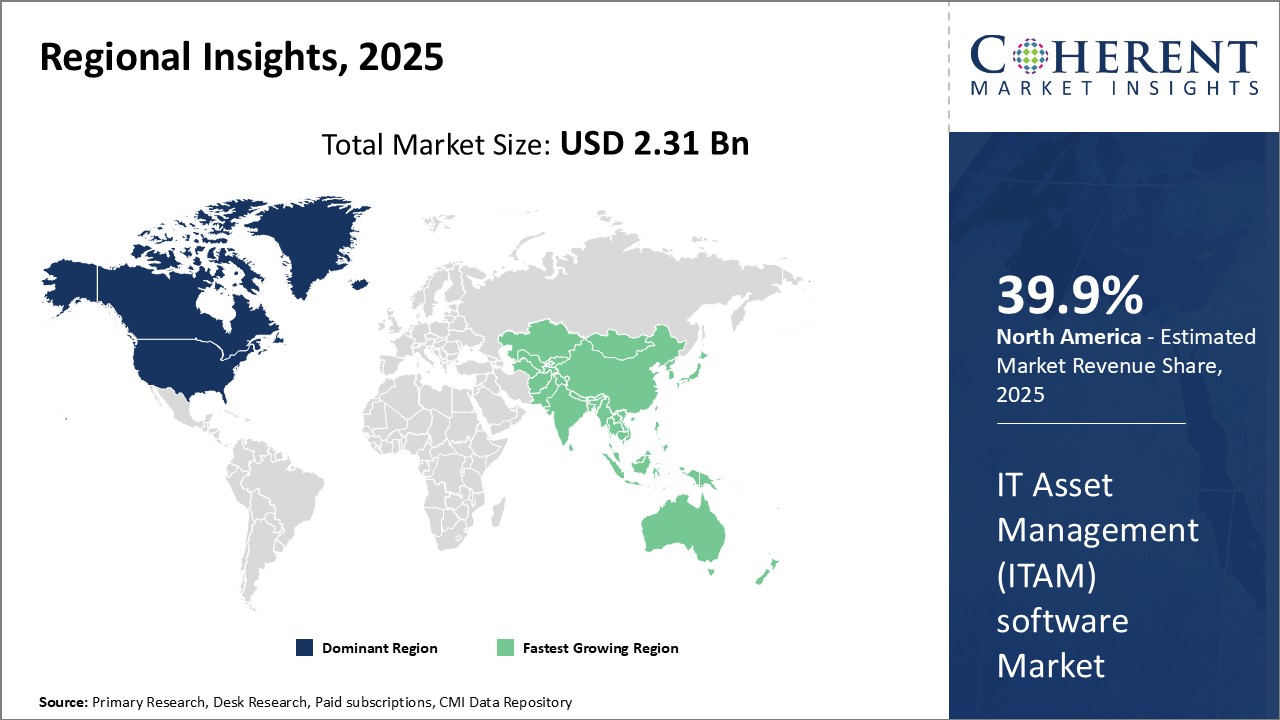
The Global IT Asset Management (ITAM) software Market is estimated to be valued at US$ 2.31 Bn in 2025 and is expected to reach US$ 3.54 Bn by 2032, exhibiting a compound annual growth rate (CAGR) of 6.3% from 2025 to 2032.

Discover market dynamics shaping the industry: Download Free Sample
ITAM software helps organizations track software licenses and manage IT infrastructure assets over their entire lifecycle. Increased focus on risk management and compliance is driving more companies to adopt ITAM solutions. Growing need to manage complex IT infrastructure and reduce operational costs is prompting more organizations to adopt ITAM software. Additionally, rise of cloud computing and proliferation of IoT devices are fueling the adoption of asset management platforms. However, budget constraints of small and medium enterprises may limit demand to some extent over the next few years.
Increasing demand for automated IT asset management processes
The escalating complexity of modern IT environments has made it exceedingly challenging for organizations to manually manage their diverse physical and virtual IT assets. Tracking thousands of devices, software licenses, contracts, and maintenance agreements spread across different departments and locations has become an overwhelming task. Manual processes are error-prone and fail to provide real-time visibility into asset utilization and compliance. This lack of visibility hinders organizations' ability to make optimal investment decisions, effectively manage contracts, and ensure software license compliance.
As a result, organizations are finding it increasingly difficult to maintain control and oversight over their IT infrastructure. The sheer scale and distributed nature of modern IT environments have rendered traditional manual approaches ineffective. Organizations must seek more sophisticated solutions and strategies to gain the necessary visibility and control required to efficiently manage their complex IT assets and make informed, data-driven decisions. To address these challenges, organizations are now looking at ITAM solutions that can automate and optimize key asset management processes. Automation helps gain visibility into the entire asset landscape via centralized asset databases. It enables automated software license optimization, contract management and hardware inventory tracking. Advanced capabilities like predictive analytics and AI are also helping optimize procurement through demand forecasting. Automation streamlines activities like software license reconciliation, hardware refresh planning and license true-ups. It minimizes human errors and ensures all assets are appropriately tagged, tracked, and maintained as per internal policies and external compliance mandates. This improves overall IT spending efficiency while mitigating compliance and security risks. More organizations recognize that investing in automated ITAM tools can deliver significant return on investment by way of cost optimization, risk avoidance, and process improvement over the long term.
For instance, in January 2022, MEGA International, a global software company renowned for its leadership in enterprise architecture for 13 consecutive years, forged a partnership with Eracent. Eracent is a prominent provider of automated Software Asset Management (SAM) and IT Asset Management (ITSM) solutions, designed to assist organizations in overcoming the challenges associated with managing software licenses and computing assets. Through this collaboration, MEGA International and Eracent aim to offer comprehensive solutions that enable organizations to effectively manage their software and IT assets.

Get actionable strategies to beat competition: Download Free Sample
Focus on IT asset optimization and cost control
In the current economic scenario, organizations across industries are looking at ways to further maximize returns from their existing IT investments. With almost all businesses now heavily relying on digital infrastructure, even a small percentage of waste in IT spending translates into substantial losses. At the same time, IT budgets are also under renewed pressure and scrutiny. There is growing emphasis on justifying every dollar spent on technology. This has motivated organizations to closely monitor their hardware, software and cloud assets to identify optimization opportunities. IT leaders want to ensure every existing and new asset is fully utilized, costs are controlled with prudence and waste is eliminated.
Comprehensive ITAM solutions can play a big role in achieving these optimization and cost control objectives. Advanced capabilities like predictive analysis of asset usage patterns, centralized software license management and granular budget tracking allow optimal deployment of existing hardware and licenses. ITAM solutions also help evaluate alternative procurement options by comparing total cost of ownership of assets. Their contract management modules help renegotiate unfavourable agreements.
Key Takeaways from Analyst:
Organizations across all industries are increasingly recognizing the need to optimize their IT asset utilization to better manage costs. The rise of cloud computing and mobile devices has made IT infrastructures more complex to track and maintain, driving the demand for comprehensive ITAM solutions. Additionally, stringent compliance regulations around software licensing and procurement are prompting businesses to formally track asset lifecycles.
North America will continue to dominate the IT Asset Management (ITAM) software Market owing to strict federal compliance mandates and early technology adoption among enterprises. However, Asia Pacific is expected to emerge as the fastest growing regional market. This can be attributed to rising investments in digital transformation initiatives, increasing use of IoT and mobility solutions among companies, and growing need to streamline aged IT infrastructure in developing economies like India and China.
While ongoing trend of remote workforces may restrain on-premise deployment of ITAM software in the short term, the long-term outlook remains positive. Vendors are enhancing their offerings to support hybrid work models through enhanced cloud-based capabilities and mobile accessibility. Growing emphasis on subscription-based pricing models is also expanding the total addressable market for ITAM providers. Increasing investments in training and consulting services around implementation and integration indicate strong demand from customers as well.
Market Challenges: Budgetary constraints
Budgetary constraints are significantly restraining the growth of the global IT asset management (ITAM) software market. Many organizations, especially small and medium-sized enterprises, are cautious about investing in additional IT solutions due to economic uncertainties caused by the ongoing COVID-19 pandemic and global supply chain disruptions. Assessing the return on investment for ITAM software requires initial capital outlay and operating expenses which are challenging for cost-focused businesses in the current difficult macroeconomic environment.
Furthermore, the market growth also depends on upgrades and replacement purchasing cycles of the existing customers. However, limited financial resources are compelling companies to extend the life of their current IT assets, rather than procure the latest ITAM solutions with enhanced features. This deferment of hardware and software refresh cycles is negatively impacting the repeat sales potential of the ITAM software vendors. Stricter budget controls have gained prominence as organizations aim to optimize existing technology investments and focus on cost-saving measures like virtualization of assets.
Market Opportunities: Integration of AI and IoT
The integration of artificial intelligence and internet of things technologies provides immense opportunities for the global IT Asset Management (ITAM) software Market. AI and IoT allow for advanced automated asset discovery, inventory management and optimization of asset utilization. With billions of internet-connected devices generating massive amounts of data worldwide, AI can help analyze this data to gain valuable insights into asset performance, location, usage and provide personalized recommendations for maintenance and upgrades.
AI-powered predictive analytics on IoT data helps identify assets nearing end of life well in advance to enable proactive replacement planning. This enhances overall efficiency of IT asset lifecycle management. Furthermore, AI combined with IoT sensors enables around the clock remote monitoring of environmental conditions, hardware status and usage patterns of physical assets. Any anomalies or potential issues can be instantly detected and addressed to avoid unplanned downtime. As workplaces transition to hybrid models, AI and IoT also support flexible management of mobile and distributed IT assets used by remote/mobile workers from any location.

Discover high revenue pocket segments and roadmap to it: Download Free Sample
Insights, By Type - Increased Automation and Flexibility Boosts Software Demand
In terms of Type, the Software segment is estimated to hold 61.9% share of the market in 2025 owing to its ability to automate and streamline IT asset management tasks. Software solutions offer increased flexibility and scalability compared to hardware-based systems. Software-based IT Asset Management (ITAM) solutions provide centralized visibility and control over software licenses, enabling organizations to easily track and optimize their software assets. These platforms offer a comprehensive view of installed software across the enterprise, ensuring appropriate license quantities are purchased and compliance is maintained. Automated features, such as usage tracking, expiring license alerts, and license true-ups, eliminate the need for manual effort in repetitive asset management tasks.
The adaptability of software-based ITAM solutions allows IT teams to quickly adjust to changing business requirements with minimal disruption. Functions can be easily added or removed from the platform as needs evolve, providing the flexibility to scale and adapt. Additionally, remote access capabilities enable organizations, particularly large multi-national companies with distributed workforces, to efficiently manage assets across multiple geographic locations from any internet-connected device.
The automation and flexibility offered by software-based ITAM solutions directly address key challenges faced by organizations, contributing to their widespread adoption and high market share. By providing centralized visibility, automated optimization, and adaptable functionality, these solutions empower organizations to effectively manage their software assets, optimize investments, and maintain compliance in today's complex IT environments.
Insights, By Deployment Type - Cloud Dominates with Lower Costs and On-demand Scalability
In terms of Deployment Type, the Cloud segment is estimated to account for 56.3% share of the market in 2025 owing to advantages like lower upfront costs and on-demand scalability. With cloud-hosted ITAM solutions, there is no need for expensive hardware purchases or lengthy on-premise installations. Vendors handle all infrastructure maintenance and upgrades behind the scenes, eliminating associated costs for customers. Organizations only pay for what they use each month through an operational expenditure model, helping reduce unpredictability in budgeting compared to one-time capital expenditure on perpetual on-premise licenses.
The scalable and elastic nature of cloud-based ITAM solutions ensures the platforms can flex up or down based on real-time asset inventory and license usage trends. Storage, computing power, and number of concurrent users can be added or removed on-the-fly as business needs fluctuate. This on-demand provisioning is not possible with rigid on-premise versions.
Furthermore, multi-tenancy enables the sharing of computing resources between different customer tenants, lowering the overall costs of cloud hosting. Mobility is another key advantage, as authorized users can access data from anywhere on any internet-connected device.
Given these compelling financial and operational benefits, cloud has emerged as the preferred deployment mode, fueling its leadership position in the ITAM market. The ability to eliminate infrastructure costs, scale resources dynamically, and provide ubiquitous access has made cloud-based ITAM solutions the go-to choice for organizations seeking to efficiently manage their complex IT assets.
Insights, By End-use Industry - Comprehensive Visibility and Controls Drives IT & Telecom Adoption
In terms of End-use Industry, IT and Telecom contributes the 36.8% share in 2025 for the market owing to unique visibility and control requirements. IT and telecommunication companies deal with an enormous and dynamic pool of hardware, software and networking assets spread both internally as well as externally with customers. Delivering ubiquitous connectivity and digital solutions relies on optimized utilization of distributed IT resources. However, the geographical dispersion and constant churn of assets make manual tracking nearly impossible. Comprehensive IT Asset Management (ITAM) solutions address this pressing need by providing centralized visibility into the complete asset lifecycle, from procurement to allocation to retirement.
Automated software metering, hardware discovery, and inventory management capabilities offer a single source of truth, enabling data-driven decision-making around capacity planning, license optimization, and spend analysis. Equally important are the granular security and usage controls that ITAM solutions provide, preventing misconfiguration and enforcing compliance by limiting employee access to only their allocated assets.
Cohesive governance facilitated by ITAM platforms helps IT and telecom organizations extract maximum value from their assets while minimizing compliance risks. These capabilities make ITAM solutions a critical tool for organizations seeking to optimize the utilization of their distributed IT resources and ensure efficient management of their complex asset ecosystems.
As a result, IT and telecom majors form a major client segment that capitalizes on the comprehensive monitoring and control capabilities offered by ITAM platforms, enabling them to effectively manage their vast and dynamic technology infrastructures.

Need a Different Region or Segment? Download Free Sample
North America is estimated to dominate the global IT Asset Management (ITAM) software Market with 39.9% share in 2025, led by strong demand from the region's large enterprises. The presence of key technology companies and early adopters of cloud and mobility solutions has propelled IT infrastructure modernization initiatives in sectors such as financial services, healthcare and manufacturing. Furthermore, rigorous regulatory compliance for data and asset security has encouraged organizations to implement centralized ITAM platforms for improved visibility and control over their digital assets. Going forward, the region's transition to cloud-first strategies is expected to further stimulate demand as businesses look to gain optimization benefits through flexible Software-as-a-Service models.
Among other regions, Asia Pacific has emerged as the fastest growing regional market for ITAM solutions in recent times. Rapid digitization of industrial and business processes across the region's developing economies has amplified the volumes of digital assets that need to be tracked, optimized and retired. At the same time, growing awareness about reducing total IT expenditure through asset lifecycle governance is motivating Asian companies to invest in next-generation ITAM offerings. In addition, favorable government support for technology adoption through subsidies and infrastructure development programs are providing a strong impetus. Local presence of global cloud providers and expanding partner networks of leading ITAM vendors have also improved the accessibility of cost-effective solutions. These factors have firmly established Asia Pacific as the new hotbed for future growth in the ITAM software space.
IT Asset Management (ITAM) Software Market Report Coverage
| Report Coverage | Details | ||
|---|---|---|---|
| Base Year: | 2024 | Market Size in 2025: | USD 2.31 Bn |
| Historical Data for: | 2020 To 2024 | Forecast Period: | 2025 To 2032 |
| Forecast Period 2025 to 2032 CAGR: | 6.3% | 2032 Value Projection: | USD 3.54 Bn |
| Geographies covered: |
|
||
| Segments covered: |
|
||
| Companies covered: |
Altaro Software, Atlassian, BMC Software Inc., Cherwell Software, Deloitte, Flexera Software LLC, Hewlett Packard Enterprise Development LP, IBM Corporation, JustSAMIt, Microsoft Corporation, Oracle Corp., Samanage, Scalable Software, ServiceNow Inc., and Snow Software |
||
| Growth Drivers: |
|
||
| Restraints & Challenges: |
|
||
Uncover macros and micros vetted on 75+ parameters: Get instant access to report
*Definition: The Global IT Asset Management (ITAM) Software Market consists of solutions that help organizations track, manage and optimize their IT assets throughout the asset lifecycle - from procurement to deployment to retirement. ITAM solutions help streamline asset tracking, software license management and compliance, optimize software spending, facilitate hardware and software audits and ensure regulatory compliance related to IT asset usage and disposal. ITAM software allows IT teams to gain visibility into all IT assets, automate workflows, reduce costs and extract more value from existing IT investments.
Share
Share
About Author
Monica Shevgan has 9+ years of experience in market research and business consulting driving client-centric product delivery of the Information and Communication Technology (ICT) team, enhancing client experiences, and shaping business strategy for optimal outcomes. Passionate about client success.
Missing comfort of reading report in your local language? Find your preferred language :
Transform your Strategy with Exclusive Trending Reports :
Frequently Asked Questions
Joining thousands of companies around the world committed to making the Excellent Business Solutions.
View All Our Clients